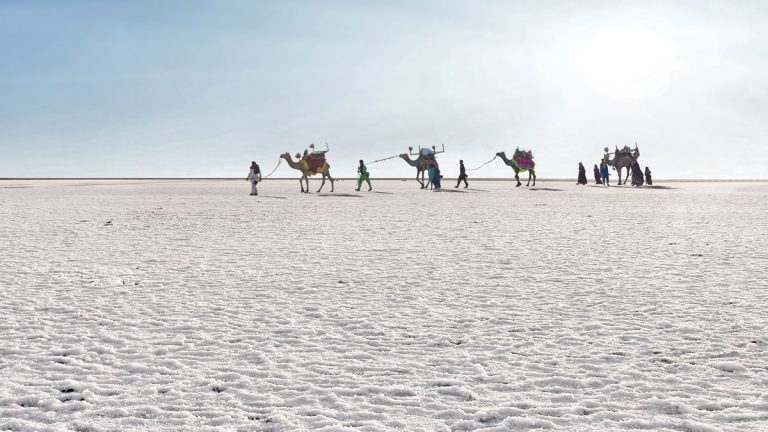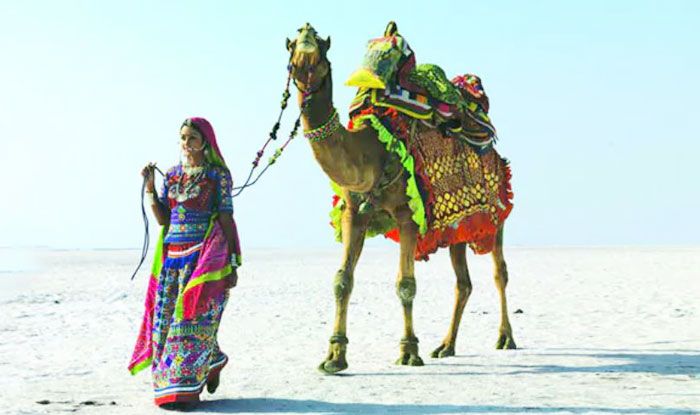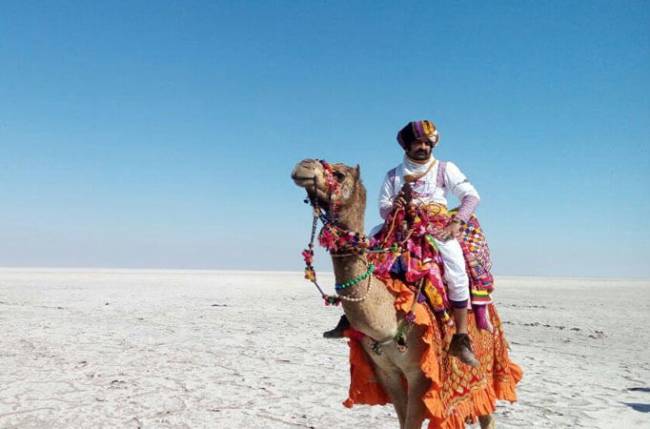
Sindh had strong political, cultural and literary relations with Kachh since long. The area was connected with Sindh by fourteen routes.
By Noor Ahmed Janjhi
Kachh (Also spelled as Kutch) had remained closely associated with Sindh, as Sindh had strong political, cultural and literary relations with it since long. It was called ‘chodanhn charo kachhro’(Kachh through fourteen routes) by classical and folk poets of Sindh. Shah Latif says:
راءَ سين رُٺا جي ، تن جاڙيجن جاڙ ڪئي
ڪيئن ماڻيندا سي ، چوڏهن چارو ڪڇڙو
The area was connected by fourteen routes with Sindh. Moreover, some parts of Kachh had been under the command of the Puran, eastern tributary of the Indus River. Kachh has traces of Indus Valley Civilization (2800-2200 BC) and when Alexander of Macedon, reached in the area, Kachh was no longer an arm of the sea. The eastern branch of the Indus—then the most important channel—emptied itself into the Rann, so that Kachh was a kind of extension of Sindh on the other side of a large freshwater lake, easily to be crossed (The Black Hills by L.F Rushbrook Williams). All of these connections were badly disturbed when the area was attacked by Mian Ghullam Shah Kalhoro twice and third time by his son Mian Sarfaraz Kalhoro. Before discussing the attacks by Mian Ghullam Shah, let us look at the history of Kachh.
Dr. James Burges has described the land of Kachh as follows:
“Kachh lies between 22, 46 N, the latitude of Navanar Point, and the parallel of 24 and between 68, 32 and 71 3 of East longitude, having an extreme length of 168 miles, and a breath varying from 48 miles in the west to scarcely 30 in the east and at one place between Dudhi and Bachau, of only 13 miles.”
Kachh is a Sindhi word with the meaning of an arm pit. As the area emerged after recession of the sea and remained arm of the sea, so it was called Kachh. People in Sindh call the south as Kachh after it.
 According to the Bombay Gazetteer of Cutch district, during the attacks by Mian Ghullam Shah, Rao Godji II (1760-1778) ruled there. Punja was his friend who did expect to be a minister but he could not get the position. He was well aware about the Kalhora rulers of Sindh. He came to Virawai in Parkar and then he made correspondence with Mian Ghullam Shah through Gidumal, who was caste fellow of Punja. Responding to the correspondence, Mian Ghullam Shah sent £ 1500 (1000 mohars) for his expenses and a palanquin with an escort of 100 men and welcomed him warmly on his arrival. Mian Ghullam Shah shared his wish to conquer Kachh and gained the Rao’s sister in marriage. It encouraged Punja slightly but he strongly recommended for attack on Bhuj and subsequent victory, a sin qua non for the marriage. Rao Godji was also aware of it so he directed his minister Jivan to summon the Abdasa and Vagad Girasias to defend the country. The whole Bhayad except Mothala chief, a friend of Punja, took field under the command of minister. Godji remained at Bhuj. Mian Ghullam Shah and Punja proceeded from Hyderabad with 70,000 men. On the way at Narra Island, they found wells filled with stones. The Kachh troops were encamped at Jara hills and they allowed Sindhian army to refresh themselves.
According to the Bombay Gazetteer of Cutch district, during the attacks by Mian Ghullam Shah, Rao Godji II (1760-1778) ruled there. Punja was his friend who did expect to be a minister but he could not get the position. He was well aware about the Kalhora rulers of Sindh. He came to Virawai in Parkar and then he made correspondence with Mian Ghullam Shah through Gidumal, who was caste fellow of Punja. Responding to the correspondence, Mian Ghullam Shah sent £ 1500 (1000 mohars) for his expenses and a palanquin with an escort of 100 men and welcomed him warmly on his arrival. Mian Ghullam Shah shared his wish to conquer Kachh and gained the Rao’s sister in marriage. It encouraged Punja slightly but he strongly recommended for attack on Bhuj and subsequent victory, a sin qua non for the marriage. Rao Godji was also aware of it so he directed his minister Jivan to summon the Abdasa and Vagad Girasias to defend the country. The whole Bhayad except Mothala chief, a friend of Punja, took field under the command of minister. Godji remained at Bhuj. Mian Ghullam Shah and Punja proceeded from Hyderabad with 70,000 men. On the way at Narra Island, they found wells filled with stones. The Kachh troops were encamped at Jara hills and they allowed Sindhian army to refresh themselves.
After taking rest for two days, Mian Ghullam Shah marched and attacked the hill. They opened fire and because of the bursting sounds, the Kachh army became disordered. Taking advantage of this disorder, the Sindhian troops climbed the hill with swords and destroyed the Kachh troops. Jivan, the minister, the sons of the Thakur of Nara and other prominent persons were killed in the fight. Rao, expressing regret, sent messenger to Punja for a truce and returning back of Sindhian army. Punja, explaining the hard terrain of return and strong defence at 360 forts and Bhuj, motivated Ghullam Shah to return back and allow him to proceed for Bhuj to arrange the marriage with Rao’s sister. Ghullam Shah agreed to it but took Punja’s son as the hostage. Punja became engaged in the settlement of the affairs of state.
Two years passed by but the matter of the marriage with Rao’s sister was not resolved. Rao was also not satisfied with the conduct of Punja. Punja was arrested, imprisoned for ten days and was poisoned to death by Rao himself. On hearing it, Ghullam Shah proceeded with 50,000 men for second attack in 1765. Crossing through Nara, he massacred all of the eighty persons at Muru Garrison, and advanced unopposed within the sight of Bhuj. Encamping at Rodar Mata within the five miles of the town, he sent his emissary Gidumal to meet the Roy. The Roy received them with little courtesy and refused to give any satisfactory answer for marriage affair. At night, when envoys were passing through the town, all of the guns were fired. It alarmed them and they returned back with exaggerated accounts of the defence of the town. After a few days, Mian Ghullam Shah received a message of compromise that he would get the daughter of the chief of Khakhar, near kinsmen of Rao instead of the Rao’s sister. Ghullam Shah returned after a few days and left 5000 men at the post of Lakhpat. By this time, he built a bank at Ali Bunder across the Kori mouth of the Indus. Consequently the rice belt of the Lakhpat turned into a salt belt. It caused an annual loss of £ 20, 000 (8 lakh koris).
 Seven years after this fight, in 1772, Ghullam Shah Kalhoro died and was succeeded by his son Mian Sarfaraz who soon got in troubles at his own court and withdrew his men from the outpost of Lakhpat. He allowed Deviji son of Punja to return back to Bhuj. Rao warmly welcomed him and offered employment with the warning of the fate of his father and ordered to strengthen Lakhpat. On his return from Lakhpat, he was poisoned to death on his way.
Seven years after this fight, in 1772, Ghullam Shah Kalhoro died and was succeeded by his son Mian Sarfaraz who soon got in troubles at his own court and withdrew his men from the outpost of Lakhpat. He allowed Deviji son of Punja to return back to Bhuj. Rao warmly welcomed him and offered employment with the warning of the fate of his father and ordered to strengthen Lakhpat. On his return from Lakhpat, he was poisoned to death on his way.
Third attack by Mian Sarfaraz Kalhoro in 1774/1775
Mian Sarfaraz proceeded for Kachh in 1775 by taking the route of Khavda and Sumrasar, intending to march to Bhuj, but the accounts of the strong defence of Bhuj, he diverted his army to Chobari and Kanthkot and married with the daughter of Thakor. After levying fines at Adhoi and other places, he returned back to Sindh. Mr. Ghullam Muhammad Lakho, with reference of Tuhfatul Karam authored by Mir Ali Sher Qani, writes that Mian Sarfaraz had proceeded to Kachh in 1774 and was welcomed by the ruler of Kachh. He got married with the daughter of Dadu Jarejo of Kanthkot. Mian returned successfully to Sindh in December 1774 AD.
These attacks reflect the interest of the rulers of Sindh in Kachh. They attacked at the instigation of Punja who had a grudge against the Roy Godji. The other main factor is to have royal Kachhi women in marriage. Mian Ghullam Shah kept a condition in this regard and urged Punja to convince Rao to marry his sister with him (Mian Ghullam Shah). The second attack was made because of the no fulfilment of the condition about marriage. At last, a girl from the royal family was given in marriage to Mian Ghullam Shah. Mian Sarfaraz also had marriage with the daughter of Jadeja of Kanthkot.
The important point of the attacks reflects stoppage of the water of Indus. It disturbed Sindh’s command and claim over Kachh. The stoppage embankment at Ali Bunder, checked the water of Puran and the rice belt of Lakhpat turned into a salt belt. Moreover, Puran itself became dried and wharf of Wango was also deserted because of the drying up of Puran.
References
- Antiquities of Kachh and Kathiawar by James Burgess
- The Black Hills, Kutch in History and Legend
- Gazetteer of Bombay Government, the District of Cutch
- Kalhora Daur e Hukoomat by Dr. Ghullam Muhammad Lakho
[author title=”Noor Ahmed Janjhi” image=”https://sindhcourier.com/wp-content/uploads/2021/05/Noor-Ahmed-Janjhi-Sindh-Courier.jpg”]Noor Ahmed Janjhi is a senior educationist based in Desert District Tharparkar Sindh. He is author of several books in Sindhi and English on folk literature including two poetry books.[/author]